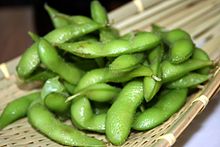Edamame

Boiled green fruit soybeans in the pod.
|
|
| Course | Appetizer, side dish |
|---|---|
| Main ingredients | Soybeans |
| |
|
| Nutritional value per 100 g (3.5 oz) | |
|---|---|
| Energy | 509 kJ (122 kcal) |
|
9.94 g
|
|
| Sugars | 2.18 g |
| Dietary fiber | 5.2 g |
|
5.2 g
|
|
|
10.88 g
|
|
| Vitamins | |
| Thiamine (B1) |
(17%)
0.2 mg |
| Riboflavin (B2) |
(13%)
0.155 mg |
| Niacin (B3) |
(6%)
0.915 mg |
| Pantothenic acid (B5) |
(8%)
0.395 mg |
| Vitamin B6 |
(8%)
0.1 mg |
| Folate (B9) |
(78%)
311 μg |
| Vitamin C |
(7%)
6.1 mg |
| Vitamin E |
(5%)
0.68 mg |
| Vitamin K |
(26%)
26.8 μg |
| Minerals | |
| Calcium |
(6%)
63 mg |
| Iron |
(17%)
2.27 mg |
| Magnesium |
(18%)
64 mg |
| Manganese |
(49%)
1.024 mg |
| Phosphorus |
(24%)
169 mg |
| Potassium |
(9%)
436 mg |
| Zinc |
(14%)
1.37 mg |
|
|
|
|
|
| Percentages are roughly approximated using US recommendations for adults. Source: USDA Nutrient Database |
|
Edamame /ˌɛdəˈmɑːmeɪ/, or edamame bean, is a preparation of immature soybeans in the pod, found in the cuisine of China, Japan, Korea and Hawaii. The pods are boiled or steamed and served with salt. In Japan, it is usually blanched in 4% salt water and not served with salt. When the beans are outside the pod, the term mukimame is sometimes used.
The Japanese name, edamame, is used commonly to refer to the dish. It literally means, "stem bean" (枝 eda = "branch" or "stem" + 豆 mame = "bean"), because the beans were often sold while still attached to the stem.
The earliest documented reference to the term "edamame" dates from the year 1275, when the Japanese monk Nichiren wrote a note thanking a parishioner for the gift of "edamame" he had left at the temple. In 1406 during the Ming Dynasty in China, the leaves of the soybeans were eaten and during outbreaks of famine, it was recommended for citizens to eat the beans whole or use them ground up and added to flour. Years later in China in 1620 they are referred to again, but as Maodou, which translates to the term “hairy bean”. They are found in the records of the Runan vegetable gardens and stated as having a medicinal purpose as well as being a snack type food. Edamame appeared in haikai verse in Japanese in the Edo period (1603 – 1868), with one example as early as 1638. They were first recognized in the United States in 1855 when a farmer commented on the difficulties he had shelling them after harvest. In March 1923, the immature soy bean is first referred to in text in the United States. In this book they are first pictured and shown as being eaten out of open shell pods. The first nutritional facts about them are published and some recipes are included as they were a new type of vegetable to the public. The earliest recorded usage in English of the word edamame is in 1951 in the journal Folklore Studies.Edamame appeared as a new term in the Oxford English Dictionary in 2003, and in the Merriam-Webster dictionary in 2008. In 2008, the first soybeans were grown in Europe to be sold in grocery stores as edamame and eaten as an alternative source of protein.
...
Wikipedia
